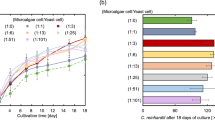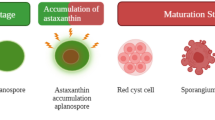Abstract
This study investigated the effects of different temperature conditions on the comprehensive metabolite profiles of Chlorella vulgaris using gas chromatography–mass spectrometry coupled with multivariate statistical analysis. C. vulgaris cells cultivated at 20 °C were transferred to 10 °C incubators at different time points of cultivation [days 0 (TR0D), 7 (TR7D), and 14 (TR14D)], then they were cultivated at 10 °C until harvesting at day 21 to compare the growth and comprehensive metabolite profiles with those cultivated under a constant cultivation temperature of 20 °C (T20). There was no significant difference in algal cell growth between cultivation under the T20 and temperature reduction (TR) conditions. Algal fatty-acid profiles under TR were different from those of the T20 condition. Specifically, the contents of octadecanoic acid (C18:0), octadecenoic acid (C18:1), hexadecadienoic acid (C16:2), and octadecadienoic acid (C18:2) increased the most under TR0D. The relative levels of metabolites such as β-alanine, glutamine, glycine, isoleucine, proline, valine, and myo-inositol, which act as osmolytes, and bioactive compounds such as neophytadiene and ascorbic acid were increased under TR conditions on day 21. Among the metabolites, the contents of neophytadiene and ascorbic acid were further investigated, and the content of ascorbic acid was highest on day 14 under the TR7D condition, while the content of neophytadiene was highest on day 21 under the TR0D and TR14D condition. Therefore, we suggest that a TR from 20 to 10 °C could enhance the production in C. vulgaris cultures of bioactive fatty acids such as C18:1, C16:2, and C18:2 (TR0D), organic osmolytes such as β-alanine, glutamine, glycine, isoleucine, proline, valine, and myo-inositol (TR conditions), ascorbic acid (TR7D), and neophytadiene (TR0D and TR14D).


Similar content being viewed by others

References
Agrawal SC, Singh V (2001) Viability of dried cells, and survivability and reproduction under water stress, low light, heat, and UV exposure in Chlorella vulgaris. Isr J Plant Sci 49:27–32
Beck EH, Fettig S, Knake C, Hartig K, Bhattarai T (2007) Specific and unspecific responses of plants to cold and drought stress. J Biosci 32:501–510
Borowitzka MA (1995) Microalgae as sources of pharmaceuticals and other biologically active compounds. J Appl Phycol 7:3–15
Borowitzka MA (2013) High-value products from microalgae—their development and commercialisation. J Appl Phycol 25:743–756
Brown MR, Miller KA (1992) The ascorbic acid content of eleven species of microalgae used in mariculture. J Appl Phycol 4:205–215
Brown M, Mular M, Miller I, Farmer C, Trenerry C (1999) The vitamin content of microalgae used in aquaculture. J Appl Phycol 11:247–255
Cabrita MT, Vale C, Rauter AP (2010) Halogenated compounds from marine algae. Mar Drugs 8:2301–2317
Chen M, Tang H, Ma H, Holland TC, Ng K, Salley SO (2011) Effect of nutrients on growth and lipid accumulation in the green algae Dunaliella tertiolecta. Bioresource Technol 102:1649–1655
Chisti Y (2007) Biodiesel from microalgae. Biotechnol Adv 25:294–306
Converti A, Casazza AA, Ortiz EY, Perego P, Del Borghi M (2009) Effect of temperature and nitrogen concentration on the growth and lipid content of Nannochloropsis oculata and Chlorella vulgaris for biodiesel production. Chem Eng Process 48:1146–1151
Dauta A, Devaux J, Piquemal F, Boumnich L (1990) Growth rate of four freshwater algae in relation to light and temperature. Hydrobiologia 207:221–226
Dejoye C, Vian MA, Lumia G, Bouscarle C, Charton F, Chemat F (2011) Combined extraction processes of lipid from Chlorella vulgaris microalgae: microwave prior to supercritical carbon dioxide extraction. Int J Mol Sci 12:9332–9341
Delauney AJ, Verma DPS (1993) Proline biosynthesis and osmoregulation in plants. Plant J 4:215–223
Haghjou MM, Shariati M, Smirnoff N (2009) The effect of acute high light and low temperature stresses on the ascorbate–glutathione cycle and superoxide dismutase activity in two Dunaliella salina strains. Physiol Plantarum 135:272–280
Herrero M, Ibáñez E, Cifuentes A, Reglero G, Santoyo S (2006) Dunaliella salina microalga pressurized liquid extracts as potential antimicrobials. J Food Protect 69:2471–2477
Hu Q, Sommerfeld M, Jarvis E, Ghirardi M, Posewitz M, Seibert M, Darzins A (2008) Microalgal triacylglycerols as feedstocks for biofuel production: perspectives and advances. Plant J 54:621–639
Huntley ME, Redalje DG (2007) CO2 mitigation and renewable oil from photosynthetic microbes: a new appraisal. Mitig Adapt Strat Global Change 12:573–608
Khalil ZI, Aske MM, El-Sayed S, Kobbia IA (2010) Effect of pH on growth and biochemical responses of Dunaliella bardawil and Chlorella ellipsoidea. World J Microb Biot 26:1225–1231
Khoeyi ZA, Seyfabadi J, Ramezanpour Z (2012) Effect of light intensity and photoperiod on biomass and fatty acid composition of the microalgae, Chlorella vulgaris. Aquacult Int 20:41–49
Kim J, Lee C (2005) Systemic optimization of microalgae for bioactive compound production. Biotechnol Bioproc Eng 10:418–424
Laurens LM, Quinn M, Van Wychen S, Templeton DW, Wolfrum EJ (2012) Accurate and reliable quantification of total microalgal fuel potential as fatty acid methyl esters by in situ transesterification. Anal Bioanal Chem 403:167–178
Lee SY, Kim SH, Hyun SH, Suh HW, Hong SJ, Cho BK, Lee CG, Lee HG, Choi HK (2014) Fatty acids and global metabolites profiling of Dunaliella tertiolecta by shifting culture conditions to nitrate deficiency and high light at different growth phases. Process Biochem 49:996–1004
Li F, Bian CS, Xu JF, Pang WF, Liu J, Duan SG, Lei ZG, Jiwan P, Jin LP (2015) Cloning and functional characterization of SAD genes in potato. PLoS One 10:e0122036
Liu S, Ruan W, Li J, Xu H, Wang J, Gao Y, Wang J (2008) Biological control of phytopathogenic fungi by fatty acids. Mycopathologia 166:93–102
Mata TM, Martins AA, Caetano NS (2010) Microalgae for biodiesel production and other applications: a review. Renew Sust Energ Rev 14:217–232
Morimoto T, Nagatsu A, Murakami N, Sakakibara J, Tokuda H, Nishino H, Iwashima A (1995) Anti-tumour-promoting glyceroglycolipids from the green alga, Chlorella vulgaris. Phytochemistry 40:1433–1437
Nappo M, Berkov S, Codina C, Avila C, Messina P, Zupo V, Bastida J (2009) Metabolite profiling of the benthic diatom Cocconeis scutellum by GC-MS. J Appl Phycol 21:295–306
Olofsson M, Lamela T, Nilsson E, Bergé JP, Del Pino V, Uronen P, Legrand C (2012) Seasonal variation of lipids and fatty acids of the microalgae Nannochloropsis oculata grown in outdoor large-scale photobioreactors. Energies 5:1577–1592
Plaza M, Santoyo S, Jaime L, Avalo B, Cifuentes A, Reglero G, García-Blairsy Reina G, Señoráns FJ, Ibáñez E (2012) Comprehensive characterization of the functional activities of pressurized liquid and ultrasound-assisted extracts from Chlorella vulgaris. Food Sci Technol 46:245–253
Praveenkumar R, Shameera K, Mahalakshmi G, Akbarsha MA, Thajuddin N (2012) Influence of nutrient deprivations on lipid accumulation in a dominant indigenous microalga Chlorella sp., BUM11008: evaluation for biodiesel production. Biomass Bioenerg 37:60–66
Raven JA, Geider RJ (1988) Temperature and algal growth. New Phytol 110:441–461
Rodríguez-Meizoso I, Jaime L, Santoyo S, Cifuentes A, García-Blairsy Reina G, Senorans F, Ibáñez E (2008) Pressurized fluid extraction of bioactive compounds from Phormidium species. J Agric Food Chem 56:3517–3523
Sharma KK, Schuhmann H, Schenk PM (2012) High lipid induction in microalgae for biodiesel production. Energies 5:1532–1553
Singh J, Gu S (2010) Commercialization potential of microalgae for biofuels production. Renew Sust Energ Rev 14:2596–2610
Singh S, Kate BN, Banerjee U (2005) Bioactive compounds from cyanobacteria and microalgae: an overview. Crit Rev Biotechnol 25:73–95
Singh L, Poddar N, Dar T, Rahman S, Kumar R, Ahmad F (2011) Forty years of research on osmolyte-induced protein folding and stability. J Iran Chem Soc 8:1–23
Spolaore P, Joannis-Cassan C, Duran E, Isambert A (2006) Commercial applications of microalgae. J Biosci Bioeng 101:87–96
Wen ZY, Chen F (2003) Heterotrophic production of eicosapentaenoic acid by microalgae. Biotechnol Adv 21:273–294
Widjaja A, Chien C, Ju Y (2009) Study of increasing lipid production from fresh water microalgae Chlorella vulgaris. J Taiwan Inst Chem Eng 40:13–20
Xiao Y, Zhang J, Cui J, Feng Y, Cui Q (2013) Metabolic profiles of Nannochloropsis oceanica IMET1 under nitrogen-deficiency stress. Bioresource Technol 130:731–738
Xin L, Hong-Ying H, Yu-Ping Z (2011) Growth and lipid accumulation properties of a freshwater microalga Scenedesmus sp. under different cultivation temperature. Bioresource Technol 102:3098–3102
Yeh K, Chang J (2012) Effects of cultivation conditions and media composition on cell growth and lipid productivity of indigenous microalga Chlorella vulgaris ESP-31. Bioresource Technol 105:120–127
Acknowledgments
This research was supported by the Basic Core Technology Development Program for the Oceans and the Polar Regions of the National Research Foundation (NRF) funded by the Ministry of Science, ICT, and Future Planning (NRF-2011-0021055) and by the National Research Foundation of Korea (NRF) grant funded by the Korean government (MSIP) (NRF-2015R1A5A1008958).
Author information
Authors and Affiliations
Corresponding author
Additional information
Hye Min Ahn and So-Hyun Kim contributed equally to this work.
Electronic supplementary material
Below is the link to the electronic supplementary material.
Fig. S1
Schematic diagram of the metabolic pathway and relative levels of the main components of C. vulgaris. This diagram was modified from pathways presented in the KEGG database (http://www.genome.jp/kegg/). Data are mean and SD values for six measurements (n = 6, biological triplicate and experiment duplicate). ANOVA and post-hoc Tukey’s tests (p < 0.05) were conducted, and different superscript letters indicate significant differences. The error bar indicate SD values. (PDF 235 kb)
Rights and permissions
About this article
Cite this article
Ahn, H.M., Kim, SH., Hyun, SH. et al. Effects of the timing of a culture temperature reduction on the comprehensive metabolite profiles of Chlorella vulgaris . J Appl Phycol 28, 2641–2650 (2016). https://doi.org/10.1007/s10811-016-0817-4
Received:
Revised:
Accepted:
Published:
Issue Date:
DOI: https://doi.org/10.1007/s10811-016-0817-4



